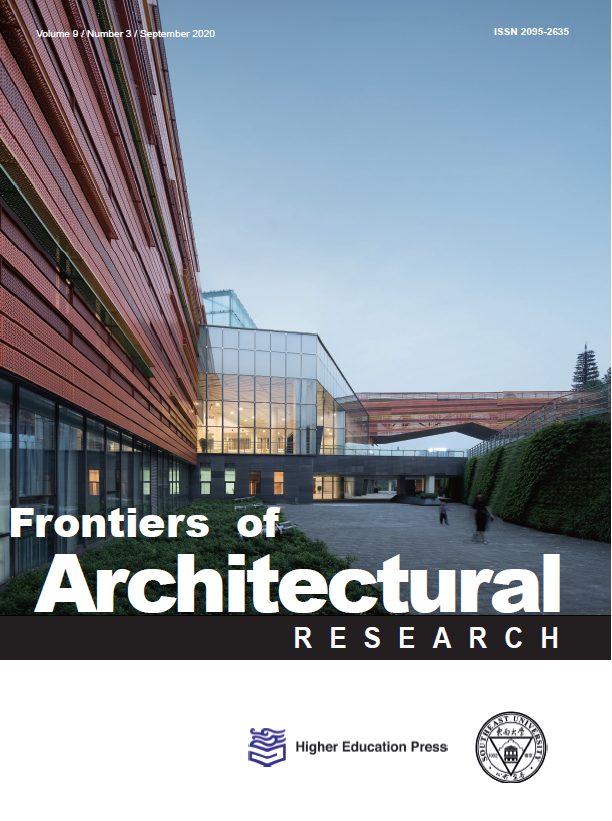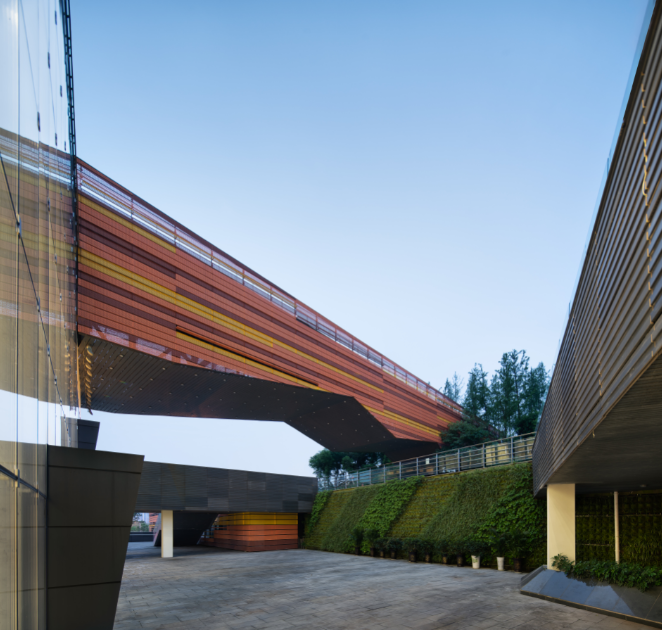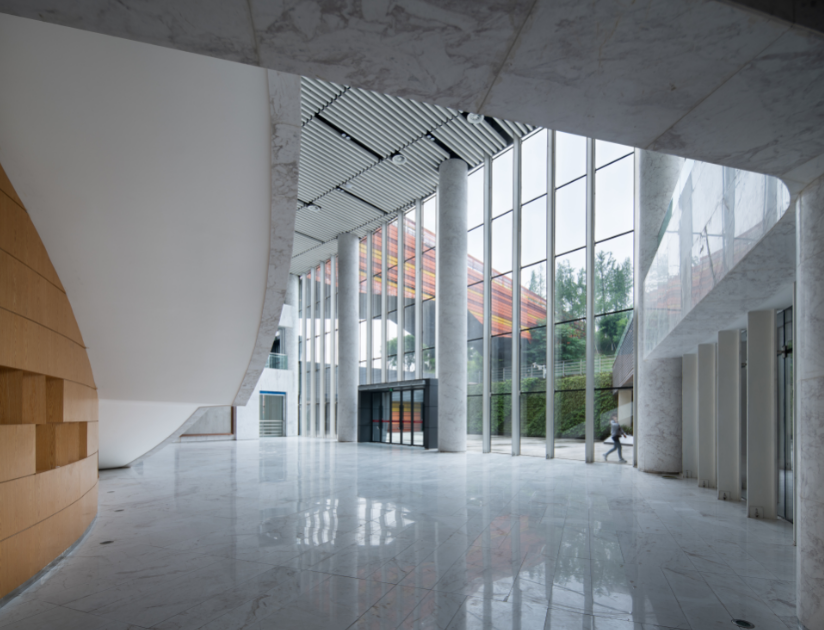
FoAR︱Frontiers of Architectural Research丨2020年第3期内容概要

Frontiers of Architectural Research
Volume 9/ Issue 3/ September 2020 (Pages 485 - 710)
共刊载15篇文章。包含了建筑设计,建筑历史,城市设计,建筑技术等各个方向。论文全部通过严格的同行评议,内容和质量均符合本刊的定位。文章来自中国、荷兰、澳大利亚、英国、日本、加拿大、新加坡、墨西哥、印度、埃及等国家。
文章目录如下:
From “planning in section” to “semi-duplex”: The New Humanism and the alternate-corridor technique
Alejandro Pérez-Duarte Fernández, José Manuel Falcón Meraz
Pages 485-497
A review of computerized hospital layout modelling techniques and their ethical implications
Navid Jamali, Ramsey K. Leung, Stephen Verderber
Pages 498-513
Design framework for robotic surgery wards at hospitals: Computational implementation
Randa M.A. Mahmoud, Amr M.A. Youssef
Pages 514-540
Characteristics of the site selection and the layout of the Great Wall of the Ming dynasty from a military perspective: Xiaohekou section as an example
Yang Shen, Qingshang Su, Tingli Jia, Xiaodi Zhou
Pages 541-555
A full moon in another land: The Moon Bridge in the Japanese garden of the Huntington Library
Yan Liu
Pages 556-567
Complexities of practicing architectural regionalism in India: An interview study
Sanyam Bahga, Gaurav Raheja
Pages 568-578
Perception of privacy in a university building: The transparency paradox
Salomé A. Bentinck, Clarine J. van Oel, Machiel J. van Dorst
Pages 579-587
Study on the inter-village space of a traditional village group in Huizhou Region: Hongguan Village group as an example
Yifei Pei, Kai Gong, Jiawei Leng
Pages 588-605
Determining transit nodes for potential transit-oriented development: Along the LRT corridor in Addis Ababa, Ethiopia
Eden Atsbeha Teklemariam, Zhongwei Shen
Pages 606-622
Design response to rising sea levels in the Maldives: A study into aquatic architecture
Ahdha Moosa, Khoa Do, Emil Jonescu
Pages 623-640
Importance and performance of streetscapes at a tourism destination in Indonesia: The residents’ perspectives
Marly Valenti Patandianan, Hiroyuki Shibusawa
Pages 641-655
Fences of childhood: Challenging the meaning of playground boundaries in design
Alkistis Pitsikali, Rosie Parnell
Pages 656-669
Game of capitals: Production of influential online architecture
Xiaoxin Zhao
Pages 670-680
Design, construction, and thermal performance evaluation of an innovative bio-based ventilated façade
Ester Pujadas-Gispert, Mohammed Alsailani, K.C.A. van Dijk (Koen), A.D.K. Rozema (Annine), ... S.P.G. Moonen (Faas)
Pages 681-696
Analyzing capacity of a consumer-grade infrared camera in South Africa for cost-effective aerial inspection of building envelopes
Naadir Vorajee, Asit Kumar Mishra, Amit Kumar Mishra
Pages 697-710
全文免费下载,请点击下面“阅读原文”。
https://www.sciencedirect.com/journal/frontiers-of-architectural-research/vol/9/issue/3
封面作品介绍:Luzhou Civic Center
项目名称:泸州市市民中心
LOCATION: Luzhou City, Sichuan, China
项目地点:中国四川,泸州市
DESIGN FIRM: Architects & Engineers Co., Ltd. of Southeast University
设计单位:东南大学建筑设计研究院有限公司
ARCHITECT: Dongqing HAN, Liang TAN, Cheng DU
主持设计:韩冬青,谭亮,都成
DESIGNER: Liang TAN, Cheng Du, Chong ZHANG, Jinwei ZHAO, Xin LI, Fei YE, Lei ZHANG, Dajun SONG, Guangming DING
设计团队:谭亮,都成,张翀,赵晋伟,李鑫,叶飞,张磊,宋大军,丁光明

Luzhou Civic Center is located next to Jiucheng Avenue, a main road in theold town. The site is on the undulating terrain, which is about 75 meters fromthe corner of the Tuo River. As an important local landmark, Luzhou CivicCenter is not only a stage for cultural activities, but also a display of thewine culture of the city.
泸州市市民中心建设项目位于泸州老城的重要干道——酒城大道旁。用地距沱江转弯口约75米,地形起伏剧烈。作为当地重要的文化地标建筑,泸州市市民中心不仅是对内承载文化活动的舞台,更是向外展示泸州酒城文化的窗口。

The design is based on the conservation of the ecological landscape ofthe mountain on the site, using the strategy of geometric homogeneity betweenthe building and the mountain. The building is presented as the form of anartificial mountain intersecting with the natural one. The layout of space andform is organically combined with the complex topography, which maximizes thepublic space and coexist the building and the mountain, the man-made and thenature. It creates a cultural place with three-dimensional walking circulation,interaction of indoor and outdoor space, multi-functional area .
设计基于对场地内山体生态景观的保护,采用了建筑与自然山体几何同质化策略。建筑以人工山体的姿态呈现,与自然山体穿插互动。建筑空间和形体布局与复杂的地形地貌有机结合,在获得最大化的公共活动场地的同时,使得建筑与山体、人工与自然彼此依存,和谐共生,创建了以立体化步行流线为纽带,室内室外彼此渗透,各功能区域互为补充的文化活动场所。
The form of the building and the mountain landscape interact with eachother. The color of the building takes reference on the colorful soil of thewine cellar, unifies the whole building by colored aluminum shutters. Thecolors imply the splendid wine culture and the natural scenery of Luzhou,reflect straightforward character of the local people, and refine the feathersof local landscape.
建筑整体形态与山地景观彼此呼应,建筑色彩取泸州酒窖五色土的意涵,利用彩色铝制格栅统一整个建筑形体,其斑斓的色彩寓意数百年“窖泥”沉淀出的五彩光芒和泸州青山绿水的自然风貌,在视觉上体现了泸州甘醇浓烈的文化气质,形成了与泸州人豪放性格相得益彰的地域景观特色。

Frontiers of Architectural Research(建筑学研究前沿,FoAR)是由东南大学建筑学院和高等教育出版社联合主办的全英文学术期刊,已被A&HCI收录。FoAR 于2012年创刊,季刊(一年四期),在Elsevier平台上发行,开放获取(Open Access),免费下载。期刊论文涉及领域包括建筑设计与理论、建筑技术科学、城市规划与设计、风景园林、遗产保护等,覆盖建筑学、城乡规划和风景园林三个一级学科。本刊优先发表采用严格科学方法和前沿技术进行研究的学术论文,同时也欢迎探讨建筑社会属性的高水平文章。对所有论文将严格进行同行评议并只接受英文投稿。所有论文由东南大学负责组织同行评议。
在线投稿:
https://www.editorialmanager.com/foar/
刊物主页:
http://www.sciencedirect.com/science/journal/20952635
http://journal.hep.com.cn/foar/

建筑学研究前沿FoAR


